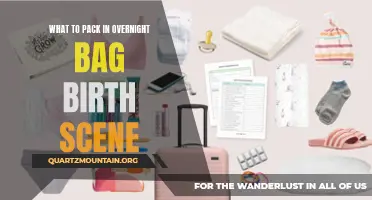
When it comes to caring for a new baby, ensuring their safety and well-being is of the utmost importance. One essential item that every parent should have on hand is a baby first aid kit. This kit is specially designed to provide immediate care in case of minor accidents or emergencies, giving parents peace of mind knowing they are prepared for any situation that may arise. From basic essentials like band-aids and antiseptic wipes to more specialized items like a digital thermometer and nasal aspirator, a baby first aid kit is a must-have for any new parent. In this article, we will discuss some of the essential items that should be included in a baby first aid kit, so that you can be fully prepared to handle any medical situation that may come your way.
What You'll Learn
- What are the essential items to include in a baby first aid kit?
- Are there any specific medications or ointments that should be included?
- Should I include a thermometer in my baby's first aid kit?
- Are there any special considerations for packing a first aid kit for a newborn?
- How often should the items in the baby first aid kit be checked or replenished?

What are the essential items to include in a baby first aid kit?

A baby first aid kit is essential for every parent to have on hand. Accidents and injuries can happen at any time, and having the necessary supplies readily available can make a difference in an emergency. Here are some essential items to include in a baby first aid kit.
- Thermometer: A digital thermometer is a crucial tool for monitoring your baby's temperature. A fever can be a sign of illness, and it's important to keep track of your baby's temperature accurately.
- Bandages and adhesive tape: Minor cuts and scrapes are common in babies as they explore their surroundings. Make sure to have an assortment of bandages and adhesive tape in different sizes to cover wounds of various sizes.
- Antiseptic wipes: To prevent any infections from developing, it's important to clean wounds thoroughly. Antiseptic wipes are a convenient and effective way to disinfect minor cuts and scrapes.
- Sterile gauze pads and adhesive bandages: Sterile gauze pads can be used to cover larger wounds, while adhesive bandages are excellent for smaller cuts and grazes. It's always a good idea to have a variety of sizes available to ensure you can cover any type of injury.
- Tweezers: Tweezers can be useful for removing splinters or debris from your baby's skin. Make sure to clean the tweezers with an antiseptic wipe before and after use to maintain cleanliness.
- Scissors: It's essential to have a pair of sharp scissors in your first aid kit to cut bandages, tape, or clothing if necessary. Opt for rounded-edge scissors, which are safer to use around your baby.
- Sterile saline solution: Sterile saline solution can be used to rinse out your baby's eyes if they come into contact with irritants, such as dirt or chemicals. Make sure to choose a saline solution specifically designed for babies.
- Fever-reducing medication: It's crucial to have an age-appropriate fever-reducing medication, such as infant acetaminophen or ibuprofen, in your first aid kit. However, you should always consult with your pediatrician before administering any medication to your baby.
- Disposable gloves: Disposable gloves should be included in your first aid kit to protect yourself and your baby from infection when administering first aid. Remember to change gloves between attending to different wounds or injuries.
- Emergency contact information: Keep a list of emergency contact numbers, such as your pediatrician's office, local hospitals, and poison control, in your first aid kit. It's also a good idea to include written instructions for infant CPR, just in case.
Remember, a baby first aid kit is only effective when you know how to use the items correctly. Consider taking a basic first aid and CPR course to ensure you have the knowledge and skills to respond appropriately in an emergency.
Essential Items for a Memorable March Trip to the Canary Islands
You may want to see also

Are there any specific medications or ointments that should be included?

When it comes to taking care of our health, there is always a need for medications and ointments to treat specific conditions. Whether it's a minor ailment or a chronic disease, having the right medications and ointments at our disposal can make a significant difference in our overall well-being. In this article, we will discuss the importance of including specific medications and ointments in our healthcare routine and provide some examples of commonly used ones.
- Pain relief medications: Pain is a common symptom experienced by many individuals, whether it's due to injury, inflammation, or chronic conditions such as arthritis. Including pain relief medications like acetaminophen or ibuprofen can help alleviate pain and improve quality of life. These medications work by blocking pain signals or reducing inflammation in the affected area.
- Antibiotics: Antibiotics are used to treat bacterial infections, which can range from minor skin infections to severe respiratory or urinary tract infections. It is important to include antibiotics in our healthcare routine, especially when prescribed by a healthcare professional. It is crucial to take antibiotics as directed and complete the full course to ensure effective treatment and prevent antibiotic resistance.
- Topical ointments: Topical ointments are applied directly to the skin and are commonly used to treat various skin conditions such as rashes, eczema, or psoriasis. These ointments can contain active ingredients like corticosteroids, antifungals, or antibacterials, depending on the specific condition. Including topical ointments in our healthcare routine can help manage and alleviate symptoms associated with skin-related issues.
- Inhalers: For individuals suffering from respiratory conditions such as asthma or chronic obstructive pulmonary disease (COPD), inhalers are essential medications that should be included in their routine. Inhalers deliver medication directly to the lungs, helping to open up airways and improve breathing. There are different types of inhalers available, including bronchodilators and corticosteroids, which serve different purposes in managing respiratory conditions.
- Medications for chronic conditions: Individuals with chronic conditions like diabetes, hypertension, or heart disease may require specific medications to manage their condition effectively. It is important to include these medications in their routine as prescribed by healthcare professionals. These medications may include blood pressure medications, cholesterol-lowering drugs, or insulin for diabetes management. Adherence to these medications is crucial to prevent complications associated with chronic conditions.
In conclusion, including specific medications and ointments in our healthcare routine is important to effectively treat various conditions and improve overall well-being. Pain relief medications, antibiotics, topical ointments, inhalers, and medications for chronic conditions are some examples of essential medications that should be included. However, it is crucial to consult with healthcare professionals for the appropriate usage and dosage of these medications to ensure safety and effectiveness.
Essential Items to Pack for a Carnival Breeze Cruise
You may want to see also

Should I include a thermometer in my baby's first aid kit?

When it comes to your baby's health and well-being, having a first aid kit on hand is essential. It allows you to quickly and efficiently respond to any minor injuries or illnesses that may arise. One commonly debated item to include in a baby's first aid kit is a thermometer. In this article, we will discuss the importance of having a thermometer in your baby's first aid kit.
Accurate temperature measurement is essential in monitoring your baby's health. Fever is often the first sign of an underlying illness or infection, and having a thermometer will allow you to accurately determine your baby's temperature. This information can be vital in deciding the appropriate course of action, whether it be administering medication, seeking medical advice, or simply providing comfort measures to help reduce fever.
There are several types of thermometers available on the market, each with their pros and cons. The most common types include digital thermometers, ear thermometers, and forehead thermometers. Digital thermometers are easy to use, accurate, and can be used rectally, orally, or under the arm. Ear thermometers provide quick and non-invasive temperature readings, while forehead thermometers offer convenience and ease of use. It's essential to choose a thermometer that suits your baby's age, comfort level, and your own preferences.
Using a thermometer correctly is crucial in obtaining accurate temperature measurements. For infants under three months old, rectal temperature measurement is recommended as it provides the most accurate reading. When using a digital thermometer, make sure to follow the manufacturer's instructions carefully. It's important to clean the thermometer both before and after each use to prevent the spread of germs. Additionally, always make sure to use a new disposable thermometer probe cover for each measurement.
Having a thermometer in your baby's first aid kit can also be beneficial in tracking your baby's temperature over time. This can be especially helpful when communicating with healthcare providers about your baby's symptoms and progress. It allows you to provide accurate and reliable information, leading to better diagnosis and treatment options.
To illustrate the importance of including a thermometer in your baby's first aid kit, let's consider an example. Imagine your baby wakes up in the middle of the night crying and feeling warm to the touch. By using a thermometer, you can quickly determine if your baby has a fever or not. If a fever is present, you can take appropriate action by providing comfort measures such as giving them a lukewarm bath or offering fluids to prevent dehydration. If the fever persists or worsens, you can seek medical advice promptly, knowing that you have accurately measured your baby's temperature.
In conclusion, including a thermometer in your baby's first aid kit is essential. It allows you to monitor your baby's temperature accurately, track their progress over time, and provide necessary medical care when needed. Choose a thermometer that suits your baby's age and comfort level, and always follow the manufacturer's instructions for accurate temperature measurement. By having a thermometer on hand, you can have peace of mind knowing that you can respond promptly and effectively to any fever or illness that may affect your baby.
Essential Items to Pack for Your Jamaican Vacation
You may want to see also

Are there any special considerations for packing a first aid kit for a newborn?

| Characteristic | Description |
|---|---|
| Name | Walgreens |
| Type | Drug store |
| Website | Go to website |
| Rating / Review count | 2.5 / 14 |
| Address | 4125 S Broad St, Hamilton Township, NJ 08620 |
| Phone | (609) 585-6500 |
| Hours | Wednesday - opens at 8 AM and closes at 10 PM Thursday - opens at 8 AM and closes at 10 PM Friday - opens at 8 AM and closes at 10 PM Saturday - opens at 8 AM and closes at 10 PM Sunday - opens at 8 AM and closes at 8 PM Monday_washington_s_birthday - opens at 8 AM and closes at 10 PM Tuesday - opens at 8 AM and closes at 10 PM |
| Profiles |   |
When it comes to packing a first aid kit for a newborn, there are a few special considerations to keep in mind. Newborn babies have delicate skin and are more susceptible to certain health issues, so having the appropriate items in your first aid kit is essential.
- Thermometer: A digital thermometer is a must-have item for a newborn first aid kit. It's important to monitor a baby's temperature regularly to detect any signs of fever or illness.
- Nasal aspirator: Newborns often have trouble with congestion due to their small nasal passages. Including a nasal aspirator in your first aid kit will help you clear their airways and make it easier for them to breathe.
- Saline drops: Saline drops are a gentle and effective way to clear a baby's blocked nose. These drops can be used in conjunction with the nasal aspirator to provide relief to a congested baby.
- Diaper rash cream: Newborns have sensitive skin, and diaper rash is a common issue. Including a diaper rash cream in your first aid kit will help soothe and protect your baby's skin.
- Infant pain reliever: It's important to have an infant-appropriate pain reliever on hand in case your baby experiences any discomfort or fever. However, it's crucial to consult with your pediatrician before administering any medication to your newborn.
- Sterile gauze pads and adhesive tape: These items are essential for dressing minor cuts or wounds. Make sure the gauze pads are sterile to prevent any infection.
- Antiseptic wipes: Keeping a supply of antiseptic wipes in your first aid kit will allow you to clean any surfaces or objects that come into contact with your newborn. It's important to maintain a clean and hygienic environment for your baby.
- Baby-friendly sunscreen: If you plan to be outdoors with your newborn, it's crucial to protect their sensitive skin from harmful UV rays. Look for a sunscreen specifically formulated for babies and include it in your first aid kit.
- Nail clippers or files: Newborns can scratch themselves accidentally, so having a pair of baby nail clippers or files in your first aid kit will allow you to trim their nails safely.
- Contact information: It's important to keep a list of emergency contact numbers, including your pediatrician and local emergency services, readily available in your first aid kit. Having this information easily accessible can save precious time in an emergency situation.
It's also important to regularly check your first aid kit for expired items and replenish any supplies that have been used. Additionally, make sure all items are stored in a secure and childproof container to prevent any accidents.
Remember to consult with your pediatrician about any specific concerns or recommendations for your newborn's first aid kit. They can provide valuable guidance on what items to include and how to use them properly.
Essential Camino Gear: What to Pack for the Journey
You may want to see also

How often should the items in the baby first aid kit be checked or replenished?

Having a well-stocked and up-to-date baby first aid kit is essential for every parent or caregiver. Accidents can happen at any time, and being prepared can make a big difference in the outcome. However, it is important to regularly check and replenish the items in the kit to ensure their effectiveness and keep your baby safe. In this article, we will discuss how often the items in the baby first aid kit should be checked or replenished, and provide you with a step-by-step guide to keeping it up-to-date.
Check expiration dates:
One of the most important aspects of maintaining a baby first aid kit is checking the expiration dates on all the items. Many first aid products, such as medications and ointments, have a limited shelf life. Expired products might not be as effective or could even be harmful. Check the expiration dates at regular intervals, ideally every six months, and replace any expired items immediately.
Inspect the packaging:
In addition to checking expiration dates, it is crucial to inspect the packaging of the items in the baby first aid kit. Look for any signs of damage, such as tears, leaks, or dents. Damaged packaging could compromise the integrity of the product, rendering it ineffective or potentially harmful. If you find any damaged items, replace them right away.
Evaluate the quantity of supplies:
Take a look at the quantity of supplies in the baby first aid kit. Depending on your baby's age and needs, you may need to replenish certain items more frequently than others. For example, diapers, wipes, and formula should be regularly restocked. Keep track of the usage and ensure there are enough supplies to last until the next replenishment. Make a checklist of essential items and check it periodically to avoid running out of important supplies.
Consider seasonal changes:
Be mindful of seasonal changes and adjust the contents of the baby first aid kit accordingly. For example, during the summer months, you might want to include items such as sunscreen, insect repellent, and a hat. Cold weather requires items like a thermometer, nasal aspirator, and extra warm clothing. Review your baby's needs based on the current season and make any necessary additions or substitutions.
Stay informed about current safety guidelines:
Keeping up with the latest safety guidelines and recommendations is crucial for maintaining an effective baby first aid kit. What might have been considered safe or effective a few years ago could have changed. Stay informed about any updated guidelines from reliable sources, such as pediatricians or child safety organizations, and make any necessary changes to your kit accordingly.
Example:
For example, let's say you have a baby first aid kit that includes adhesive bandages, antiseptic wipes, and a digital thermometer. You check the expiration dates of these items every six months and replace any expired ones. You also inspect the packaging and ensure there are no leaks or damage. You keep track of the quantity of supplies and restock as needed. During the summer, you add sunscreen and insect repellent to the kit, and during the winter, you make sure to have extra warm clothing and a nasal aspirator. You stay updated on the latest safety guidelines and make any necessary changes to the kit based on new recommendations.
In conclusion, it is important to regularly check and replenish the items in the baby first aid kit to ensure their effectiveness and keep your baby safe. Check expiration dates, inspect the packaging, evaluate the quantity of supplies, consider seasonal changes, and stay informed about current safety guidelines. By following these steps, you can maintain a well-stocked and up-to-date baby first aid kit that will be ready to handle any emergencies that may arise.
The Essential Guide to Packing for a City Break in Hand Luggage
You may want to see also
Frequently asked questions
When packing a baby first aid kit, it is important to include essential items that can be used in case of emergencies. Some items that should be included are adhesive bandages in various sizes, sterile gauze pads, adhesive tape, antiseptic wipes, and child-safe scissors. It is also important to include items like a digital thermometer, infant pain reliever, and a small first aid manual.
While it is important to have medication on hand in case of emergencies, it is recommended to consult with your pediatrician before including any medication in the baby first aid kit. Medication such as infant pain relievers or antihistamines may be included if advised by a healthcare professional. However, it is crucial to use caution and only include medications that are appropriate for your baby's age and weight.
In addition to the basic first aid supplies, there are a few additional items that can be included in a baby first aid kit. These include a flashlight with extra batteries, a pair of non-latex gloves, a breathing barrier with one-way valve for CPR, and tweezers. It may also be helpful to include a list of emergency phone numbers and any specific instructions provided by your pediatrician or healthcare provider.







